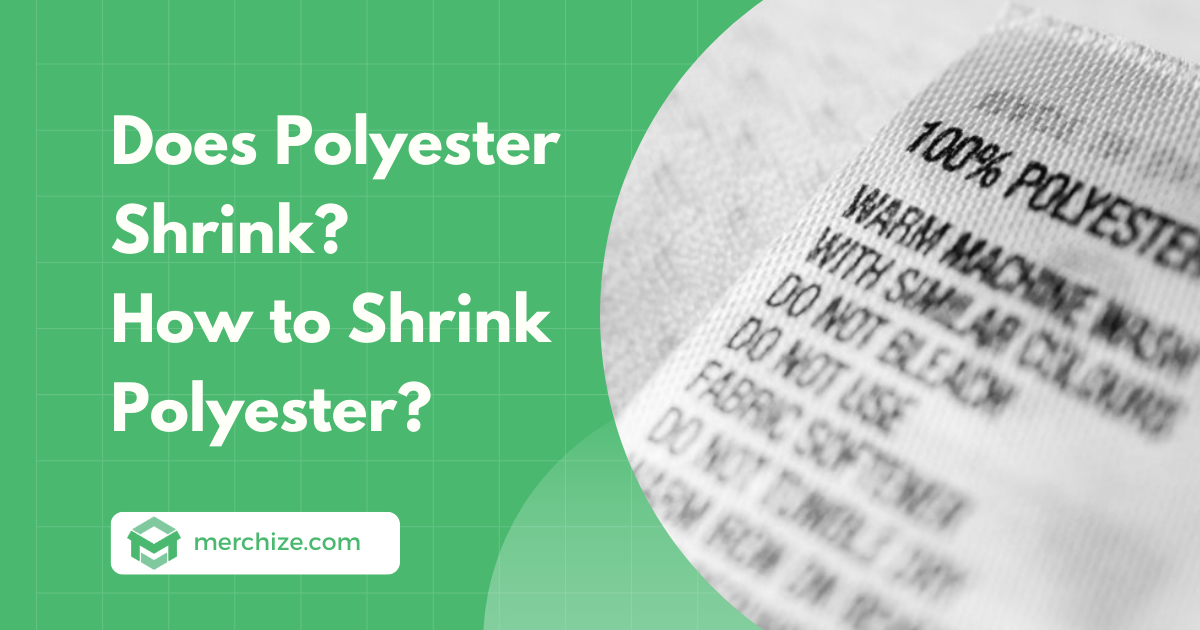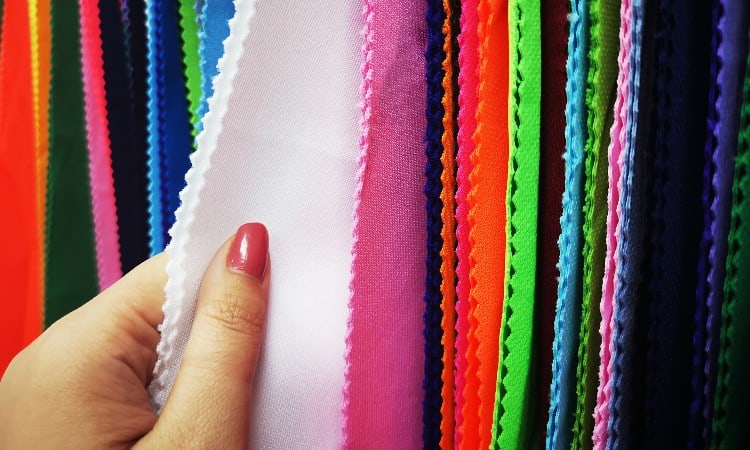Contents
Polyester is among the most popular materials used in the apparel industry. “Does polyester shrink?” – This is also a common question asked by many people, whether they want to keep polyester fabric from shrinking or to actively slim down polyester items. In this blog post, we will find the exact answer to this question along with useful care instructions for this synthetic material.
What is polyester?
For a short introduction, polyester is a synthetic material made from petroleum. First introduced by the DuPont Corporation in the 1940s, polyester has become the most widely used textile due to its outstanding durability and versatility. According to Textile Exchange’s Materials Market Report 2024, polyester accounted for 57% of total fiber production worldwide.
Polyester is a commonly used material for not only fashion clothing but also for other products like home furnishing and other industrial products. It’s often blended with natural fibers like wool or cotton to combine polyester’s durability and wrinkle resistance with the breathability and softness of natural materials.
If you are still wondering which fabric is better, polyester or cotton, read our comparison article to know which type is the best choice for your apparel product.
Does polyester shrink?
Yes. Polyester fabric can still shrink under certain conditions.
It is commonly known that polyester fibers are resistant to shrinkage, unlike other natural materials like wool or cotton. But the truth is that polyester fabrics are not entirely immune to shrinking. According to Deborah Young (The Textile Expert), polyester can shrink depending on the fabric composition and construction.
– Fabric composition: Poly blends are more prone to shrink than 100% polyester fabric. And the higher the percentage of polyester, the more resistant it is to shrinkage.
– Fabric construction also plays a role. Whether the fabric is woven or knitted also affects the level of shrinkage of a material. Knitted polyester fabric is less resistant to shrinkage than woven polyester. Woven, pure polyester fabric is less likely to reduce in size, while knitted poly blends can shrink to a noticeable degree.
In case you want to learn more about polyester fabric and other types of fabrics, read our complete guide on all the Best shirt materials and learn how to choose the right fabric for your T-shirt product.
How can you shrink polyester?
In many cases, you might want to intentionally shrink your clothing for a better fit. Whether it’s made from cotton, polyester, or blends, heat is the key to inducing shrinkage.
In the following, we will introduce a few ways you can shrink your clothes using heat.
But before starting to cause some irreversible changes to your clothes, you should be careful to examine the care instructions to see details about the fabric composition, as well as check if the fabric is woven or knitted. This way, you can adjust the heat exposure to get the desired impact. Or at least, you will know whether these methods are appropriate for the garment because exposure to a high level of heat can cause the material to lose its integrity, wear out faster, or even cause uneven shrinkage.
Use washing machine
Modern washing machines usually come with heat and dry settings, in which heat is used to wash or dry the clothes.
- Prepare your clothes for washing. Make sure the garment is flipped inside out to protect colors and prints from fading during the heat exposure.
- Set the longest cycle and hottest setting (typically 130-140°F or higher). Avoid using detergent in this process.
- After washing, if the garment hasn’t shrunk enough, you can continue to air dry or tumble dry on low heat.
Boil the fabric
If you want to shrink your clothes even more, you can try boiling your clothing to make it shrink even more.
- Flip the clothes inside out and wet the entire garment in cold water.
- Put your clothes into a large pot filled with water. Make sure that there is enough water to submerge the entire garment.
- Start to boil the water pot to around 155°F (68°C) for up to an hour. Occasionally stir the pot and check how much the garment shrinks.
- You can let the water cool out before taking the garment out. Afterward, you can use your washing machine to air dry or tumble dry the clothes. Note that you should set the heat low if the garment has shrunk enough.
Use dryer
Normally, you won’t have to worry that polyester fabric will shrink in the dryer. But if you want to actively shrink a garment, using a dryer can come as a viable option.
- Put your wet clothes into the dryer.
- For 100% polyester, set the highest heat (up to 180°F) and longest cycle. For blends, start with a lower temperature and shorter cycle to avoid damage.
Use iron
If you apply all the previous methods but haven’t got the result you expected, you can level up and use iron heat to downsize your clothes.
Normally, polyester fabrics aren’t recommended for ironing. Firstly, polyester fabrics are wrinkle-free, which means that it doesn’t need to be ironed. Secondly, direct exposure to extreme heat from iron can cause melting and damage to the polyester fibers.
Polyester’s heat resistance ability is much lower than other natural fabrics. Especially when blended with other synthetic materials like spandex and elastane, they are even more sensitive to heat.
To protect the garment from being destroyed by extreme heat, here’s what you can do:
- Boil or wash the garment in high heat beforehand
- While the garment is still wet, put it on the ironing board
- Cover the garment with a pressing cloth or towel
- Set your iron to low or medium heat, with no steam
- Iron the garment, and move the iron in a circular motion
How to wash polyester properly?
Unless your clothes are too large for your size, you would never want them to shrink. Many people are careless when it comes to taking care of their polyester garments, for these items normally don’t shrink much.
But as far as we know, even pure polyester fabric can shrink under certain circumstances. To maximize the lifespan of your garment, you should learn how to take proper care of your polyester items and avoid accidentally shrinking your clothes. Here are a few tips on how to wash polyester fabrics without making them shrink.
Follow the care instructions on the label
Care labels contain all the important instructions needed to make sure that your clothes are always in good cared.
Many care labels include detailed text instructions that are easy to understand and follow. However, sometimes these care instructions are illustrated in laundry symbols only. In these cases, you should check the meaning of these symbols.
From these symbols, you can decipher how to take care of your garments. Here is some key information that you need to pay attention to:
- What is a suitable water temperature for washing?
- Is machine washing allowed? Or is it hand-washed only?
- Is there any specific requirement for detergents (mild detergent, non-chlorine bleach)?
- What is the best way to dry the garment, air dry, or machine dry?
- What is the suitable temperature for tumble drying?
- What is a suitable temperature for ironing?
- Is it safe to use steam during ironing? Is it required to use a pressing cloth while ironing?
- Is it safe to dry clean?
- Is there any special warning or special care instructions for your items?
Pretreat the polyester clothing item
Before putting your clothes into the washing machine or starting to handwash the entire garment, you should check again for any area that requires a special pre-retreat. Cuffs, neckline, and underarms are areas that usually get stained and should be carefully examined before washing.
It is also recommended not to soak the garment in water for too long, as it can degrade the quality of the fabric.
Wash the clothes properly
For this step, make sure to strictly follow the instructions given on the care label. Use a suitable and safe detergent that won’t bleach or affect the colors of your garments. Don’t forget to set your washer to the proper cycle.
Also, heat is an extremely important factor that can diminish polyester fibers. That’s why you should always set your washing machine to the right temperature and make sure to set the right cycle.
Some types of clothing might require washing in hot water in order to get rid of all the odor and bacteria. However, make sure the temperature is within the acceptable range.
Dry your clothes carefully
Air drying is the best way to dry most fabric materials, including polyester. Still, polyester, with its durability and resistance, can hold up very well when put in the dryer. To keep the polyester fabric in the best condition, don’t use the highest temperature for drying.
FAQ:
-
Does polyester shrink in the dryer?
Yes, polyester can shrink in the dryer if exposed to high heat settings. To prevent shrinking, it’s best to use a low heat or air-dry setting when tumble-drying polyester garments. Hanging them to air dry is often a safer choice.
-
Does polyester shrink in the wash?
Generally, polyester is resistant to shrinking in the wash. However, excessive heat can cause some shrinkage. To maintain its size and shape, use a gentle or cold water wash cycle and avoid high heat when drying.
-
Does pure polyester shrink?
Pure polyester fabric is less prone to shrinking compared to natural fibers like cotton. It has good dimensional stability, meaning it retains its shape well. Still, it can shrink if subjected to high heat or improper care, so it’s essential to follow care instructions.
-
Is polyester odor-resistant?
Polyester is known for its moisture-wicking properties, which can help reduce odors by keeping you dry. While it’s not entirely odor-resistant, it is less likely to retain odors compared to some natural fibers. Regular laundering should keep it fresh.
-
Is polyester wrinkle-resistant?
Yes, polyester is naturally wrinkle-resistant due to its synthetic fibers. It tends to hold its shape well and resist creasing. However, if wrinkles do form, they are often easy to remove by hanging the garment or using a steamer.
-
Can polyester be ironed?
Yes, polyester can be ironed, but it requires caution. Use a low heat setting, and consider using a pressing cloth to protect the fabric. Avoid excessive heat, as polyester can melt or become shiny when exposed to high temperatures. Steam can be helpful for smoothing out wrinkles without direct contact with the iron. Always check the care label for specific ironing instructions.









